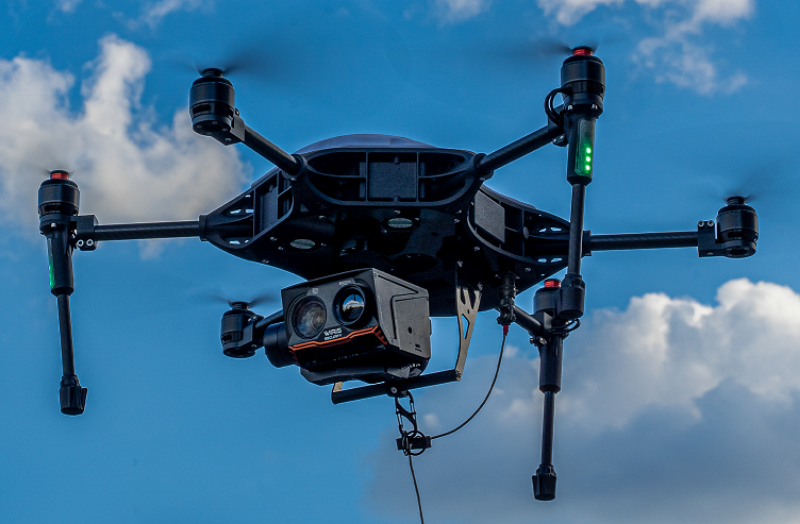Contents
- 1 AI in autonomous drones for surveillance and monitoring
- 1.1 Improved situational awareness: AI algorithms can be used to fuse data from multiple sensors to create a comprehensive view of the environment. This can help operators to identify potential threats and make informed decisions.
- 1.2 Reduced operator workload: AI algorithms can be used to automate many of the tasks that are typically performed by human operators, such as flying the drone, tracking targets, and identifying objects. This can reduce the workload on operators and allow them to focus on more important tasks.
- 1.3 FAQ
- 1.4 Tips
- 1.5 Conclusion
Images References :
Autonomous drones are becoming increasingly popular for surveillance and monitoring applications due to their ability to operate without human intervention. These drones are equipped with a variety of sensors, including cameras, thermal imaging cameras, and Lidar, which allow them to collect data on their surroundings. The data collected by these drones can then be used to create maps, track objects, and identify potential threats.
Artificial intelligence (AI) is playing a major role in the development of autonomous drones. AI algorithms can be used to process data from sensors and make decisions about how to navigate and operate the drones. This allows drones to perform complex tasks without human intervention, such as following moving targets or avoiding obstacles. AI is also used to develop new applications for autonomous drones, such as search and rescue operations and disaster response.
In this article, we will explore the use of AI in autonomous drones for surveillance and monitoring. We will discuss the different types of AI algorithms that are used in drones, and we will provide examples of how AI is being used to develop new applications for drones.
AI in autonomous drones for surveillance and monitoring
AI is playing a major role in the development of autonomous drones for surveillance and monitoring. AI algorithms can be used to process data from sensors and make decisions about how to navigate and operate the drones. This allows drones to perform complex tasks without human intervention, such as following moving targets or avoiding obstacles.
- Improved situational awareness: AI algorithms can be used to fuse data from multiple sensors to create a comprehensive view of the environment. This can help operators to identify potential threats and make informed decisions.
- Reduced operator workload: AI algorithms can be used to automate many of the tasks that are typically performed by human operators, such as flying the drone, tracking targets, and identifying objects. This can reduce the workload on operators and allow them to focus on more important tasks.
AI is still a relatively new technology, but it is rapidly being developed and refined. As AI algorithms become more sophisticated, we can expect to see even more innovative and groundbreaking applications for autonomous drones in the future.
Improved situational awareness: AI algorithms can be used to fuse data from multiple sensors to create a comprehensive view of the environment. This can help operators to identify potential threats and make informed decisions.
One of the key advantages of using AI in autonomous drones for surveillance and monitoring is that it can help to improve situational awareness. AI algorithms can be used to fuse data from multiple sensors, such as cameras, thermal imaging cameras, and Lidar, to create a comprehensive view of the environment. This can help operators to identify potential threats and make informed decisions.
For example, an autonomous drone equipped with a camera and a thermal imaging camera can be used to monitor a large area for potential threats. The camera can provide a visible image of the environment, while the thermal imaging camera can detect objects that are emitting heat. This information can be fused together to create a more comprehensive view of the environment, which can help operators to identify potential threats that may not be visible to the naked eye.
AI algorithms can also be used to track moving targets and to identify objects of interest. This information can be used to provide operators with real-time updates on the situation, and to help them to make informed decisions about how to respond to potential threats.
Improved situational awareness is essential for effective surveillance and monitoring. By using AI algorithms to fuse data from multiple sensors, autonomous drones can provide operators with a more comprehensive view of the environment, which can help them to identify potential threats and make informed decisions.
In addition to the benefits described above, AI can also be used to develop new and innovative applications for autonomous drones in surveillance and monitoring. For example, AI algorithms can be used to develop drones that can autonomously search for and track specific objects, or to identify and classify objects in real time.
Reduced operator workload: AI algorithms can be used to automate many of the tasks that are typically performed by human operators, such as flying the drone, tracking targets, and identifying objects. This can reduce the workload on operators and allow them to focus on more important tasks.
Another key advantage of using AI in autonomous drones for surveillance and monitoring is that it can help to reduce operator workload. AI algorithms can be used to automate many of the tasks that are typically performed by human operators, such as flying the drone, tracking targets, and identifying objects. This can free up operators to focus on more important tasks, such as analyzing data and making decisions.
For example, an autonomous drone equipped with AI algorithms can be programmed to automatically follow a moving target. This can free up the operator to focus on other tasks, such as monitoring the drone’s surroundings for potential threats. AI algorithms can also be used to automatically identify objects of interest, such as people or vehicles. This can help operators to quickly identify potential threats or areas of interest.
In addition to automating specific tasks, AI algorithms can also be used to improve the overall efficiency of drone operations. For example, AI algorithms can be used to develop drones that can autonomously plan and execute missions. This can free up operators to focus on other tasks, such as managing multiple drones or analyzing data.
Reduced operator workload is essential for effective surveillance and monitoring. By using AI algorithms to automate many of the tasks that are typically performed by human operators, autonomous drones can help to reduce the workload on operators and allow them to focus on more important tasks.
In addition to the benefits described above, AI can also be used to develop new and innovative applications for autonomous drones in surveillance and monitoring. For example, AI algorithms can be used to develop drones that can autonomously search for and track specific objects, or to identify and classify objects in real time.
FAQ
Here are some frequently asked questions about AI in autonomous drones for surveillance and monitoring:
Question 1: What are the benefits of using AI in autonomous drones for surveillance and monitoring?
Answer: AI can provide a number of benefits for autonomous drones used in surveillance and monitoring, including improved situational awareness, reduced operator workload, and the ability to automate complex tasks.
Question 2: What are some of the challenges of using AI in autonomous drones?
Answer: Some of the challenges of using AI in autonomous drones include developing AI algorithms that are robust and reliable, and ensuring that the drones are safe and compliant with regulations.
Question 3: What are some of the potential applications of AI in autonomous drones for surveillance and monitoring?
Answer: AI can be used in autonomous drones for a wide range of applications, including border patrol, search and rescue operations, and disaster response.
Question 4: How is AI being used in autonomous drones today?
Answer: AI is being used in a number of autonomous drones today, including the DJI Mavic 2 Enterprise and the Skydio X2. These drones use AI to perform a variety of tasks, such as tracking moving targets, identifying objects, and avoiding obstacles.
Question 5: What are the future trends for AI in autonomous drones?
Answer: The future trends for AI in autonomous drones include the development of more sophisticated AI algorithms, the integration of AI with other technologies, and the development of new applications for AI-powered drones.
Question 6: How can I learn more about AI in autonomous drones?
Answer: There are a number of resources available to learn more about AI in autonomous drones, including online articles, white papers, and conferences.
AI is a rapidly developing field, and it is expected to play an increasingly important role in autonomous drones for surveillance and monitoring in the years to come.
In addition to the information provided in the FAQ, here are some additional tips for using AI in autonomous drones for surveillance and monitoring:
Tips
Here are some tips for using AI in autonomous drones for surveillance and monitoring:
1. Use AI to automate complex tasks. AI can be used to automate a variety of tasks that are typically performed by human operators, such as flying the drone, tracking targets, and identifying objects. This can free up operators to focus on more important tasks, such as analyzing data and making decisions.
2. Use AI to improve situational awareness. AI algorithms can be used to fuse data from multiple sensors to create a comprehensive view of the environment. This can help operators to identify potential threats and make informed decisions.
3. Use AI to develop new applications. AI can be used to develop new and innovative applications for autonomous drones in surveillance and monitoring. For example, AI algorithms can be used to develop drones that can autonomously search for and track specific objects, or to identify and classify objects in real time.
4. Ensure that your AI algorithms are robust and reliable. AI algorithms should be tested and validated to ensure that they are robust and reliable. This is especially important for drones that are used in critical applications, such as search and rescue operations.
By following these tips, you can use AI to improve the effectiveness of your autonomous drones for surveillance and monitoring.
AI is a powerful tool that can be used to improve the performance of autonomous drones for surveillance and monitoring. By following the tips in this article, you can use AI to automate complex tasks, improve situational awareness, develop new applications, and ensure that your AI algorithms are robust and reliable.
Conclusion
AI is playing an increasingly important role in the development of autonomous drones for surveillance and monitoring. AI algorithms can be used to improve situational awareness, reduce operator workload, and automate complex tasks. This can make drones more effective and efficient for a wide range of applications, including border patrol, search and rescue operations, and disaster response.
As AI continues to develop, we can expect to see even more innovative and groundbreaking applications for autonomous drones in surveillance and monitoring. AI algorithms are becoming more sophisticated and more reliable, and this is making it possible to develop drones that can perform complex tasks autonomously. This will free up operators to focus on more important tasks, such as analyzing data and making decisions.
The use of AI in autonomous drones is still in its early stages, but it is clear that AI has the potential to revolutionize the way that drones are used for surveillance and monitoring. AI algorithms can make drones more effective, efficient, and reliable, and this will make them an even more valuable tool for a wide range of applications.



